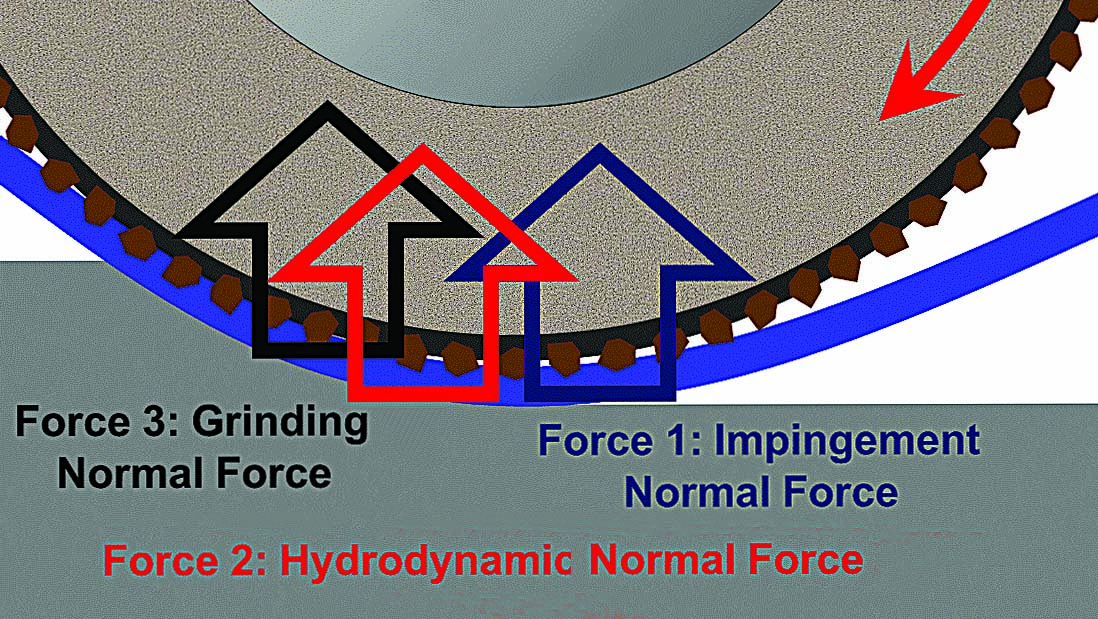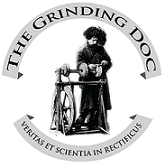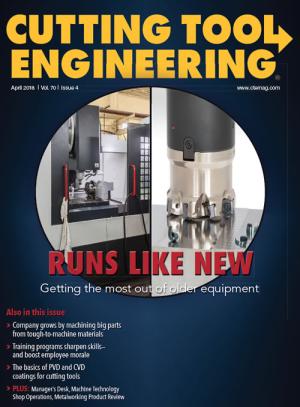Dear Doc: I get taper when cylindrical-OD grinding. Why, and what can I do about it?
The Doc Replies: Taper is often caused by upward deflection of the spindle. I’ve seen companies “cheat” by dressing a reverse taper into the wheel to counter the taper. But a better way is to attack the problem at its source: the large normal force.
The large normal force may come from the grinding—perhaps there’s too large a removal rate or, more commonly, a dull-dressed wheel. But large hydroplaning forces from the coolant are just as common a cause. These forces don’t decrease during spark-out. A 2"-wide (50.8mm) wheel can easily have 70 lbs. (31.8kg) of upward force on the spindle just from hydroplaning. That causes deflection and taper.

Hydroplaning forces, composed of the impingement force and the hydrodynamic force, can be much larger than the grinding force and cause large deflections. Image courtesy of J. Badger.
One solution is to ease off on the coolant during finish grinding and spark-out to reduce the hydroplaning forces. But don’t shut it off, or the hydroplaning wheel will crash into the part. Some machines have this option in the CNC; others don’t. Granted, you won’t be cooling as well, but we don’t need good cooling during spark-out.
Dear Doc: I use a scrubber nozzle to remove loaded nickel alloy from an Al2O3 wheel. There’s disagreement about whether it’s working. Is there a way to tell?
The Doc Replies: Yes. Dress the wheel, grind 50 parts with the scrubber on, and measure the power. Then dress the wheel, grind 50 parts with the scrubber off, and measure the power. The power signals should start at about the same level. However, after 50 parts, the power signal with the scrubber nozzle should be significantly lower than without the scrubber. If not, your scrubber is useless. And, sadly, most scrubber nozzles are useless.
Dear Doc: I’m trying to use 2"-dia., electroplated CBN wheels to grind slots in hardened steel without success. Why?
The Doc Replies: I assume you’re applying water-based coolants. Plated CBN does well with 100 percent oil as a coolant. But with any type of water-based coolant, it’s total pain and suffering. If you use water-based instead of oil, expect a huge drop in wheel life. I’m talking, say, 10 parts instead of 500 parts. If you must use water-based coolant, switch to a water-oil emulsion.
Contact Details
Related Glossary Terms
- coolant
coolant
Fluid that reduces temperature buildup at the tool/workpiece interface during machining. Normally takes the form of a liquid such as soluble or chemical mixtures (semisynthetic, synthetic) but can be pressurized air or other gas. Because of water’s ability to absorb great quantities of heat, it is widely used as a coolant and vehicle for various cutting compounds, with the water-to-compound ratio varying with the machining task. See cutting fluid; semisynthetic cutting fluid; soluble-oil cutting fluid; synthetic cutting fluid.
- cubic boron nitride ( CBN)
cubic boron nitride ( CBN)
Crystal manufactured from boron nitride under high pressure and temperature. Used to cut hard-to-machine ferrous and nickel-base materials up to 70 HRC. Second hardest material after diamond. See superabrasive tools.
- dressing
dressing
Removal of undesirable materials from “loaded” grinding wheels using a single- or multi-point diamond or other tool. The process also exposes unused, sharp abrasive points. See loading; truing.
- emulsion
emulsion
Suspension of one liquid in another, such as oil in water.
- grinding
grinding
Machining operation in which material is removed from the workpiece by a powered abrasive wheel, stone, belt, paste, sheet, compound, slurry, etc. Takes various forms: surface grinding (creates flat and/or squared surfaces); cylindrical grinding (for external cylindrical and tapered shapes, fillets, undercuts, etc.); centerless grinding; chamfering; thread and form grinding; tool and cutter grinding; offhand grinding; lapping and polishing (grinding with extremely fine grits to create ultrasmooth surfaces); honing; and disc grinding.
- spark-out ( sparking out)
spark-out ( sparking out)
Grinding of a workpiece at the end of a grind cycle without engaging any further down feed. The grinding forces are allowed to subside with time, ensuring a precision surface.



